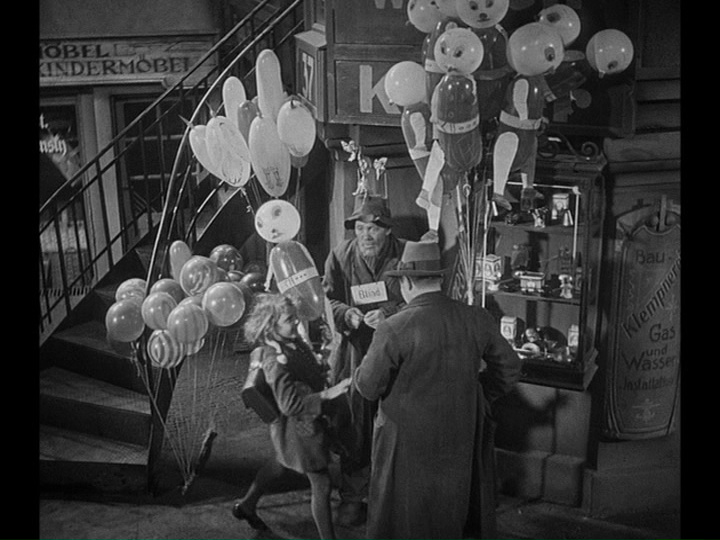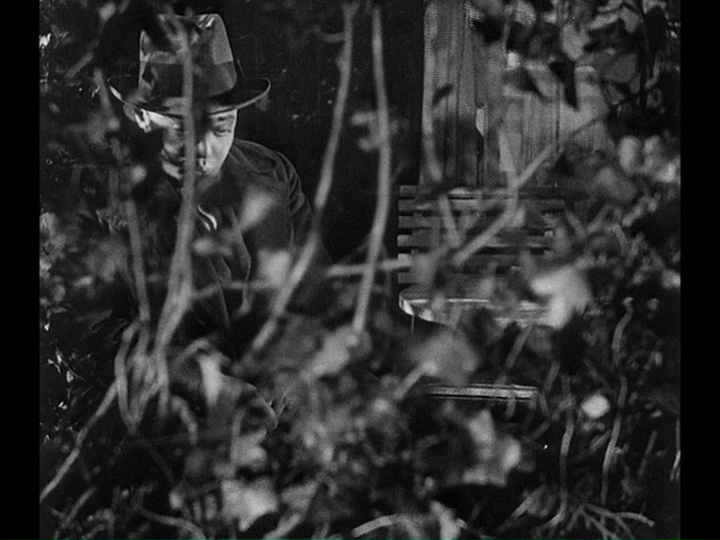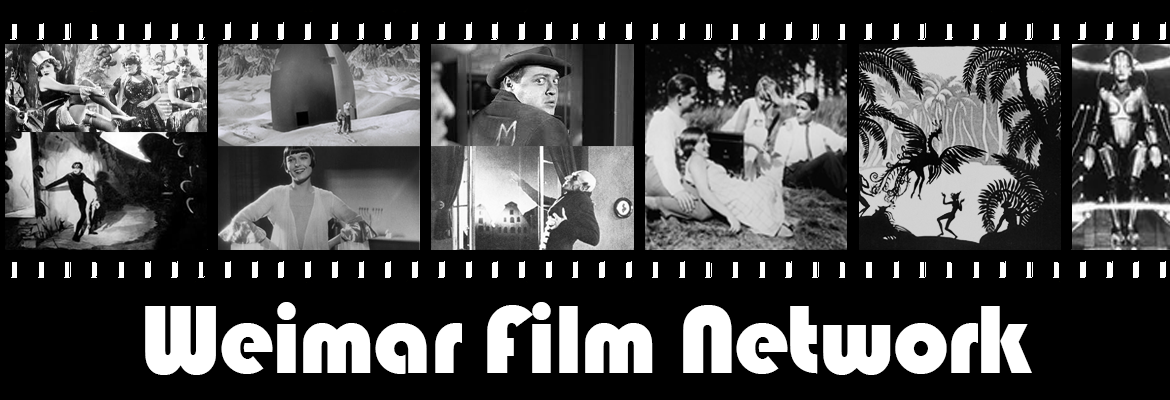A Killer(‘s) Melody: Grieg’s “In the Hall of the Mountain King” in Fritz Lang’s M
Hugo Fagandini, King’s College London
While Fritz Lang is best known for the influential imagery and ground-breaking visual set-pieces of his science-fiction epic Metropolis (1927), it is for his later M: Eine Stadt sucht einen Mörder (1931) that he and his film art remain perhaps most celebrated. Evocative even in its single-letter title of its moody aesthetic, gripping plot and emergence in the febrile atmosphere of the late Weimar Republic, M is widely considered Lang’s masterpiece, and was the director’s favourite of his own films. Certainly the visual shadow-play and moral murkiness of film noir, indeed as Lang would later advance in his own films in American exile, are inconceivable without it. Equally distinctive, however, is M’s deservedly fêted use of sound, not only reflecting the depiction in Lang and Thea von Harbou’s scenario of a Berlin that, for all its hyper-organisation and regimentation along every conceivable line, nonetheless teeters on the brink of total disorder and chaos, but furthermore taking such disjuncture as its entire approach.
The idea that Lang’s first sound film would be no ordinary one, nor merely the continuation of his silent films with the crudely added novelty of sound, is noticeable for one in M’s very different use of music compared to the director’s previous work. Indeed, gone are the stirring musical scores of Gottfried Huppertz (Metropolis, Die Nibelungen) and others that graced his previous films, furthermore bearing sole responsibility for carrying their dramatic weight on an aural level. Instead, the only “music” heard in M comes from strictly diegetic sources, i.e. within the film world seen on-screen: a barrel-organ, a children’s rhyme, a tune that the wry Inspector Lohmann (Otto Wernicke) cheekily whistles at a suspect being frisked. Most important of all, however, is the melody, similarly whistled (and famously by Lang himself), that becomes the musical calling card – heard in five separate sequences – of Peter Lorre’s child-killer Hans Beckert. This fateful theme, as this article will discuss, is from Edvard Greig’s incidental music (Op. 23, 1875) to Ibsen’s Peer Gynt, namely the cue “In the Hall of the Mountain King” (“I Dovregubbens hall”) in which Gynt, seeking to woo the titular king’s daughter for his bride, is menaced upon his arrival by the king’s “troll courtiers” who openly contemplate carving him up and “boil[ing him] into broth and bree”.
https://www.youtube.com/watch?v=4nMUr8Rt2AI
The continuous reappearance of Grieg’s melody within Lang’s film has been frequently celebrated as a Leitmotiv, and this does indeed form part of its function. As the “Leit-” prefix implies, it accordingly “leads” the viewer not only forwards through the film – namely as a recurring musical theme that comes to be associated with Beckert – but also backwards to join the associational dots between the current iteration and its predecessors. This “leading” function, however, arises not merely through repetition alone, but through melodic, harmonic or other similar transformations that reflect similar developments within the surrounding musical narrative. Beckert’s incessant whistling, by contrast, stubbornly resists this process, instead cycling continuously back to its own starting point and rarely progressing beyond the first four-bar phrase of Grieg’s melody. In this sense, it carries far more the properties of an idée fixe as devised by Hector Berlioz for his earlier Symphonie fantastique (1830), a similarly recurrent theme yet whose continual, insistent re-entry and obstinate indifference to its surrounding context provide both an appropriate and effective musical parallel for fixation, obsession and mania: fitting indeed for Beckert and the “compulsive urges” to which his whistling, as Lang remarks, “gives mute expression”.
The Leitmotiv function behind Beckert’s idée fixe is not entirely lost in M, however, in that a development can nonetheless be seen in terms of the dramaturgical purpose it serves within the narrative. Its first entry, after roughly five minutes, comes as a further instance of the status conferred upon Beckert by a terrified populace and hysterical mass media of a spectre rather than a flesh-and-blood human being: incorporeal, omnipresent and seemingly glimpsable only in snatches or fragments. While this is illustrated visually in the shadow he casts over his own wanted poster or in the view of him from behind as he buys a balloon for the ill-fated Elsie Beckmann, it is present too on an aural level in his fractured, indeed dismembered whistling of the “Mountain King” theme, its intonation intemperate and off-key and its musical phrases uneven and disjointed (Fig. 1).

Figure 1: © M (Fritz Lang, 1931)
This theme’s subsequent second appearance shortly afterwards similarly emphasises not only Beckert’s continued elusiveness, but the sense of unassailability this appears to encourage within him, as we see him (again from the back) hunched over a windowsill and scribbling a note to the city’s press, whistling while he works. Able to hide in plain sight and evade detection owing to his utterly normal, outwardly unassuming bourgeois appearance and demeanour, his use as an outlet of the democratising platform afforded by the mass print media allows him similarly to assert his voice above those of millions of others, yet be rendered instantly invisible in a great wash of mass opinion and information.
It is in this scene, barely ten minutes in, that the broader connotations and significance of Grieg’s “Mountain King” theme begin to make themselves known. For one, besides its appearance here connecting Beckert – at this stage, still nameless and unseen from the front – with the individual of Fig. 1 who purchases Elsie’s balloon, it positions similarly his bourgeois sensibilities (as well as outer appearances) as a means simultaneously of concealing and provocatively exposing himself. Kristi A. Brown writes that Ibsen’s Peer Gyntwas a perennially popular choice among contemporary German theatregoers, making for the more than reasonable assumption that this tune would not only have been instantly recognisable to a large portion of the film’s audience, but would have served to place Beckert more unambiguously within their own milieu. Displaying a casual disregard for the broader framework of Grieg’s music in favour of repeating a memorable and accessible “Ohrwurm”, his constant whistling of Grieg’s tune implies that he – presumably, much like the film’s audience – has either seen Ibsen’s play, heard the music separately (“Mountain King” forms the finale of the first of two equally successful concert suites) or, given the widespread popularity of both, simply come into contact with it through more second-hand means.
Yet the implications of this extend far beyond Beckert’s middle-class artistic tastes, revealing key insights as to how he is to be perceived in the film to come, and furthermore as to how he perceives himself. In a trademark example of Lang’s use of sound throughout the film to connect juxtaposing scenes thematically as well as structurally, the police graphologist’s comments shortly afterwards that Beckert’s handwriting reveals “ein[en] schwer erweisbaren aber intensiv fühlbaren Zug von Wahnsinn” are heard precisely as Beckert, regarding himself in the mirror, pulls grotesque faces to transform himself into the “Triebmensch” of the accompanying voice-over description. In this sense, as well as assuming with some relish the bogeyman persona assigned to him by a fearful public imagination, Beckert also assumes the role more explicitly of Ibsen’s “Mountain King” (“Dovregubben”), who lures the human Gynt into the troll world with the promise of reward and prestige before attempting to induct him by force into his people’s way of life.
As Tom Gunning writes, however, this scene presents a further, decidedly sinister turn in the internal “private drama” that rages within Beckert throughout the film as both the outer and inner manifestations of his madness threaten increasingly to break free of his conscious control, something the subsequent iterations of Grieg’s “Mountain King” melody do much to reflect. Its third entry indeed comes during another of M’s key scenes over half-an-hour later, as Beckert, gazing magpie-like at the glittering array of silverware in a shop window, catches sight of another potential victim, fatefully framed within a perfect square arrangement of dinner knives (as is Beckert himself in its reflection) that point inwards to unequivocally direct his vision (and ours). Before our eyes, no longer in the “private theatre” (Gunning, p. 179) of his mirror but in the very public arena of the open street, Beckert’s hideous transformation begins again, his face contorting and eyes bulging this time seemingly of their own accord. These same dark urges, however, also summon up from within him the strains of Grieg’s theme as he sets off in pursuit, the troll king once more with his head stooped and his sights firmly set on his target.
The next, fourth entry both provides further clues and raises further questions as to the true nature of Beckert’s unstable, unquestionably conflicted identity, with Lang’s use of sound providing a uniquely disturbing edge. Foiled in his abduction attempt as his intended victim unexpectedly reunites with her mother, Beckert heads instead for a nearby café. Here, he attempts seemingly to calm or sedate the impulsive id-being inside him with a cigarette and a brace of cognacs, yet seemingly cannot keep the melody from once again forming on his lips. This instance, at least at first, is fairly unambiguous, with the whistling heard on the soundtrack corresponding suitably with Beckert’s visibly puckered lips (Fig. 2). Its continuation, however, exploits to great effect what Michel Chion dubs “acousmatic sound”, namely sound whose source, in contrast, is not visible or otherwise identifiable on screen. Tossing the cigarette aside, Beckert clamps his hands over his ears and braces himself physically against the coffee table, his mouth now obscured by his clenched fists (Fig. 3). Yet not only does the viewer hear his whistling continue regardless, but Beckert furthermore appears to react to the sound with similar horror and dread himself. Is what we hear the sound of his whistling continuing against his conscious will? Or, more insidiously still, is it the sound in musical form of his compulsive urges clamouring or echoing inside his head?

Figure 2: © M (Fritz Lang, 1931)

Figure 3: © M (Fritz Lang, 1931)
In removing this distinction and thus toying with our expectations, M gears up for the final conclusive stage in the development of Beckert’s Leitmotiv as it completes its transformation from the conscious means through which he simultaneously asserts and conceals his individual identity into the petard with which he is ultimately hoist. Indeed, not only does his whistling, having now fully escaped his control, now inadvertently give him away in its final appearance, but furthermore, in a city where he is otherwise able to blend in undetected, gives him away to the one person whose other senses can compensate enough to truly “see” him, namely the blind pedlar who previously sold him Elsie’s balloon. The combination of image, dialogue and music as Beckert’s shadow drifts fleetingly across the wall behind the pedlar (Fig. 4), recalling and ironising his Mephistophelian first appearance, makes this new development unavoidably clear. His spell, as represented partly by his talismanic tune, is now broken, and the imposing menace he once represented now reduced to the mere shadow not only of a man, but rather – as Gustav Gründgens’s gangster ringleader Schränker would have it – to a “Bestie” that remains solely to be hunted, captured and exterminated.

Figure 4: © M (Fritz Lang, 1931)
Numerous commentators have interpreted to varying degrees and conclusions the significance behind the inclusion specifically of Grieg’s “In the Hall of the Mountain King” as a commentative intertext on Beckert’s conflicted dual nature, occupying a liminal space between man and beast. For Maria Tatar, for example, it is an expression of the pathological sexual desire that, as with Ibsen’s titular protagonist, drives Beckert to effect his transformation into a monster; for Gunning, it parallels the horror that Beckert himself experiences at confronting the monster both that dwells within him and that he in turn becomes. It is Brown, however, who teases out perhaps most extensively the connotations within the film of Grieg’s piece as a reference to the “pointedly ambiguous space” that Ibsen’s trolls – and, by extension, Lorre’s Beckert – occupy “between the human and the monstrous, the rational and the perverse”.[1] For one, as much as Beckert’s whistling of Grieg’s tune may serve both his Selbstinszenierung (conscious or otherwise) as Ibsen’s troll king and his incarnation as such by surrounding society, he is just as much the titular Gynt, who ventures confidently into the trolls’ dank underworld and dabbles with their “me-first” philosophy, only to be ultimately driven out for his unwillingness to convert fully to their cause.
Ultimately, however, this further “jumbl[ing of] the categories of monsters and men” serves above all to highlight the true poignancy, if not tragedy of Beckert’s position. Far from being merely a monster, “Triebmensch” or “Bestie” among humans (this, as witnessed in the mirror scene, is rather what he desires to become), he is instead caught between two worlds, impelled by dark urges towards his terrible crimes while remaining sufficiently socialised to be tormented equally by his guilt and remorse. Moreover, this liminality – unlike the gangsters’ in their life of crime, and furthermore unlike Gynt’s in opportunistically turning his back on the mores of the human world only to fall afoul of the trolls’ – is the result not of his own conscious actions or choices, but instead of a cruel quirk of fate. His constant whistling of Grieg’s tune is thus in one sense bitterly ironic; whether it is Gynt or the Mountain King that he imagines himself becoming when doing so, it is inevitably towards the other that he ends up being drawn.
As much sympathy or understanding as may thus be curried for Beckert’s predicament, both von Harbou’s dialogue and commentaries particularly such as Tatar’s remind us that his actions nonetheless carry far-reaching, horrific and irreparable consequences. Brown’s observations, however, shed greater light on the role of Grieg’s melody alongside other filmic elements in placing Beckert’s mania within a broader context rather than merely isolating it as an outlying or anomalous individual case study, and one furthermore with lessons as important for a latter-day audience as for one first watching it ninety years previously. For one, although the “Beckert case” unites Berlin’s law-abiding citizenry, law enforcement officials and criminal underworld in a coordinated effort to stop him, their desire to eliminate him as the disruptive outsider and thus restore order brings to the surface “the beast [similarly] latent within themselves” as these efforts assume increasingly extreme forms. While this suppressed bestiality surfaces in the frenzy into which large crowds are frequently driven, most forcefully of all in the closing kangaroo court sequence, the shop window scene mentioned above reveals how this is sewn into the very fabric of present-day capitalist society, the array of knives and reflective surfaces providing Beckert with both the incitement and means to continue his killing spree.
The choice, however, for Beckert’s “theme song” of a melody both easily recognisable to and indicative of the bourgeois milieu in which (notwithstanding his unspeakable deeds and psychological imbalance) he is nonetheless unmistakably embedded performs a double function in its distinct appeal to the popularity outlined above both of Ibsen’s and of Grieg’s Peer Gynt among contemporary audiences. Like the “M” (for “Mörder”) that Lang asserts can be found in the intersecting lines on every human palm, the constant return within the film of Grieg’s widely-known, indeed highly popular tune represents the shared capacity for evil, mania and murder that Lang’s film implies lies dormant within its audience as much as within its tortured protagonist, equally capable of surfacing at any time and differing only in the extent to which it is ultimately expressed. The various other subtitles appended to M at various points in its release history, after all – alongside the official “Eine Stadt sucht einen Mörder”, the working title “Mörder unter uns” and the later “Dein Mörder sieht dich an” –play on the notion of the titular murderer, far from being safely contained within the film’s diegesis, in fact being much more within the viewer’s immediate vicinity. Indeed, as Lorre’s earlier face-pulling scene demonstrates, the murderer could even be staring out at them from their bedroom mirror.
Filmography
M, dir. by Fritz Lang (Nero-Film A.G., 1931)
Works consulted
Brown, Kristi A., “The Troll Among Us”, in Changing Tunes: The Use of Pre-Existing Music in Film, ed. by Phil Powrie and Robynn Stilwell (Aldershot: Ashgate, 2006), pp. 74-87
Kaes, Anton, M (London: British Film Institute, 2000)
Gandert, Gero, “Fritz Lang on M: An Interview”, in Fritz Lang: Interviews, ed. by Barry Keith Grant (Jackson, MS: University of Mississippi Press, 2003), pp. 33-37
Gunning, Tom, 'M: The City Haunted by Demonic Desire', in The Films of Fritz Lang: Allegories of Modernity (London: British Film Institute, 2000), pp. 163 - 199
Tatar, Maria, 'The Killer as Victim in Fritz Lang's M', in Lustmord: Sexual Murder in Weimar Germany (Princeton, NJ: Princeton University Press, 1995), pp. 153 - 172

